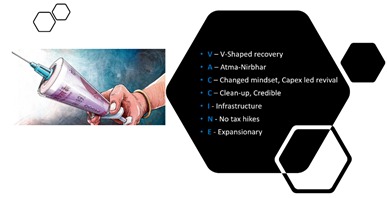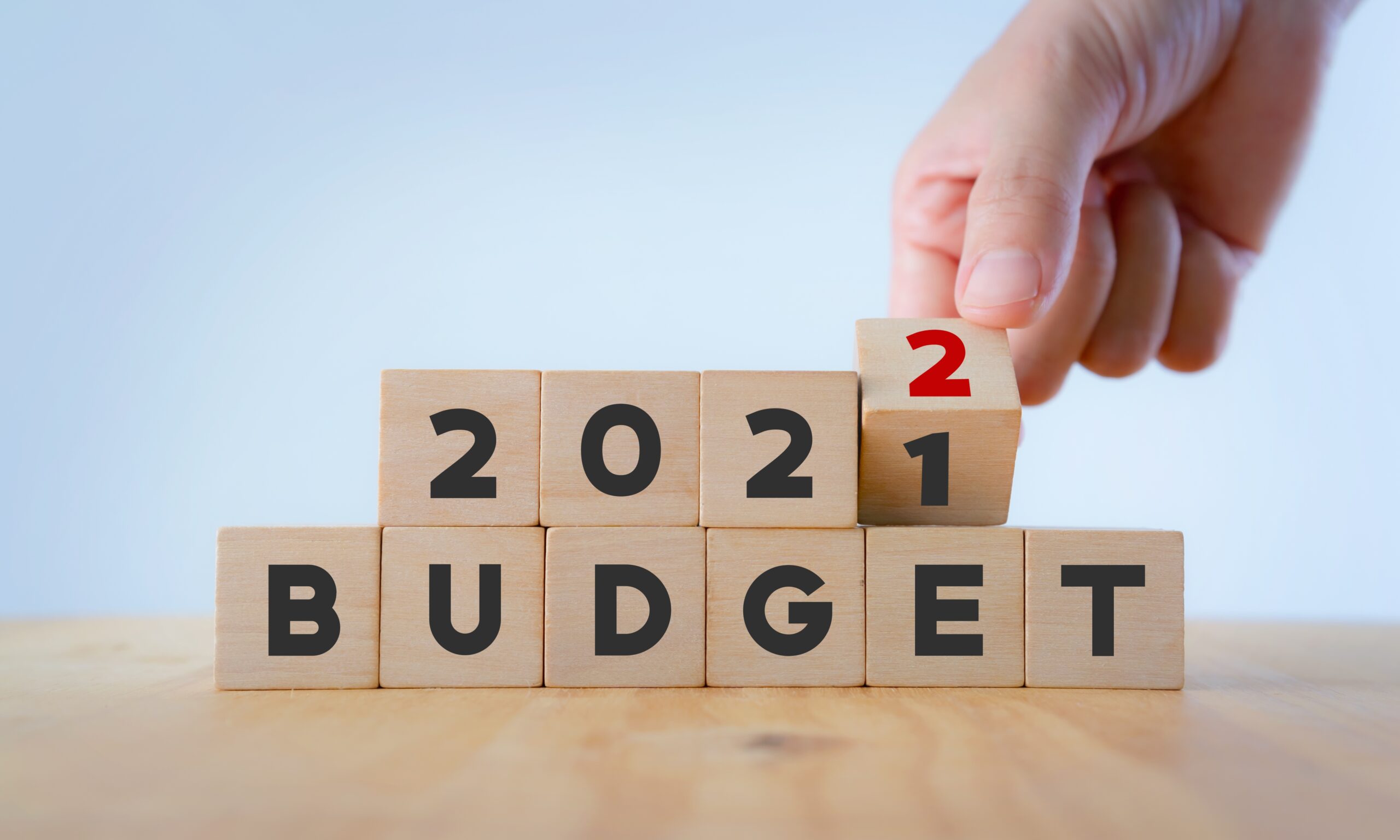Seven-dose potent VACCINE for the Indian Economy
Several pathogens had infected the Indian economy – namely consumption dip, fragile jobs ecosystem, pandemic-led social spending, reduced revenues, and fiscal-deficit tight rope walk.
A plan to combat these was well laid out in the first paperless Union Budget, through what is akin to a 7-dose “VACCINE” shot.

While the economic hygiene had been maintained all through 2020 by the Reserve Bank of India’s monetary policy, the penultimate boost to the frail economy has come in the form of Budget 2021-22.
V-shaped Recovery in sight
The Economic Survey has indicated a V-shaped recovery in the next FY 2021-22 even as an economic contraction of 7.7% has been forecasted for the FY 2020-21.
Pushing the growth multiplier rather than stoking consumption with steroids has been high on the Government’s radar.
While the easy way out could have been to induce consumption through tax rebates and money in the hands of consumers, the challenging path of concrete growth inducers such as infrastructure and investments spends were adopted.
Atmanirbhar Bharat
Taking major stride towards the aim of self-reliant India, a cushion worth Rs 1.97 lakh crore was offered to the manufacturing sector to spur domestic facilities. The electronics, automobiles and auto ancillary, telecom, pharma and textiles industries would be able to utilise the amount over a period of five years.
Additionally, seven large Mega Investment Textiles Parks (MITRA) would offer a playground of sorts to nurture global export businesses through the plug and play model over the next three years.
Capex-led revival
There is a tectonic shift in the mindset of the NDA Government that is ready to bite the risk-bullet. It has shed the crisis-management garb and adorned the capex-investment outfit, ready to tackle economic contraction head on. It is unperturbed by the additional weight of fiscal deficit.
Enhancing FY 2022 capital expenditure allocation by 26% year-on-year, the Government would spend a whopping Rs.5.5lakh crore more on creating assets like roads, railway lines, factories, ports. Spearheading the infrastructure creation drive would be the freshly created Development Finance Institution with a bounty of Rs 20,000 crore, which emphasis the thrust on physical assets.
Cleaning-up Act
There are strong indicators from the Government that it is looking to clean up its books winding down to FY 2026. The first indicator is the decision to bring all the food subsidy on its books rather than the funding through Food Corporation of India, which was an off-balance sheet funding mechanism.
Also, reliance on off-balance sheet funding through National Highways Authority of India and other extra-Budgetary resources has been reduced.
Apart from, the cleaning up drive, the Budget calculus seems to have undergone a shift toward moderate projections keeping in view the growth estimates. As a result, the estimations drawn in the Budget 2021-22 have a flavor of credibility to them.
Backing this claim is the fact that the divestment targets for FY 2021-22 have been judiciously placed 17% lower than the previous year. Gross tax revenue projections too have been pegged in line with 14.4% year-on-year rise in nominal GDP.
Infrastructure
Both physical and financial infrastructure augmentation would be carried out through various moves.
Capital expenditure has always been restricted to 13.5% of the GDP. But the infrastructure-push message has been made loud and clear with a significant allocation of 15.6% of GDP to expenditure, thereby dampening even the inflation worries.
Equity infusion of Rs 20,000 crore has been allocated for public sector banks, even as a new asset reconstruction company would take over bad bank loans. These steps are vital to improve the access to credit.
Divestment and monetization of operation assets through Infrastructure Investment Trusts would offer the Government additional strength to fund various initiatives.
No tax hikes
Similar to all the four Budgets presented after a year of contraction, the Finance Minister steered clear of any income tax raise. No hike was proposed in personal, corporate taxation or even indirect taxes. Nasty surprises in cess, capital gains or wealth tax too were kept at bay.
The move was well thought to avoid any hurdle in the way of consumption. Contemporary ways to fill the revenue gap were thought of in the form of additional borrowing, divestment, increase in insurance foreign direct investment limit and zero coupon bonds.
The sensitive side of the Government came to the fore with the advance tax alteration with respect to dividends and even offering foreign portfolio investors a reduced lower Treaty Rate for dividends income tax.
Expansionary not austere
There was a realization through various allocations that even as the fiscal deficit would expand, the purse strings will have to be loosened for growth. Developed nations too have struggled with austerity.
Back home, the Finance Minister set sights on fiscal deficit target of 6.8% of GDP getting rid of the shackles of the 3% fiscal deficit target specified by the Fiscal Responsibility and Budget Management Act. It reflects the intentions that fiscal consolidation path would extend a little longer.
The deviation in the fiscal deficit roadmap had already been trigged in FY 2020-21 owing to the pandemic-led growth infusion, which pushed the figures to 9.5% of GDP. Hence, the audacious attempt at spurring growth – even if it took longer to achieve 4.5% fiscal deficit – was undertaken.
This move would have an expansionary effect as the investment would have a spill over across multiple sectors due to improvement in employment opportunities and in turn money in the hands of individuals.
Conclusion
Just like the six pillars that the Budget 2021-22 was placed on, the seven key VACCINE doses are pertinent.
To conclude, the medicine in the right dosage will have to be administered if the economy has to bounce back and hurl past the reach the $5-trillion GDP mark by 2024-25. There could be certain adverse reactions (read: ballooning fiscal deficit). But the prescription seems to be based on the correct prognosis of what Bharat needs in the long run.
Disclaimer, Disclosures & Important notices:
This document prepared by ValueQuest Investment Advisors Ltd, is meant for the sole use of the recipient and not for public circulation. This document should not be reported or copied or made available to others, either in part or full. The information contained herein is obtained based on internal data and publicly available information and other sources believed to be reliable.
ValueQuest does not claim or warrant the accuracy, correctness or completeness of the data mentioned herein. As such, this document should not be relied upon for any purposes including investments in any security. This document is for personal information only and does not constitute an offer, invitation, or inducement to invest in any security whatsoever. ValueQuest or any of its employees are under no obligation to update the information contained in this document. As permitted by SEBI regulation, ValueQuest and its affiliates, associates, officers, directors, and employees, including persons involved in preparation of this document may: (a) from time to time have a long or short position, or buy or sell, any of the securities of any company mentioned herein or otherwise; or (b) be engaged in any other transaction involving such securities. Performance related information provided in this document is not verified by SEBI. Past performance is not a guide for future performance.
Investment in equities involves substantial risk including permanent loss of capital (in whole or in part) and hence may not be suitable for all investors. The statements contained herein may include statements of future expectations and other forward-‐looking statements that are based on our current views and assumptions and involve known and unknown risks and uncertainties that could cause actual results, performance, or events to differ materially from those expressed or implied in such statements. Readers shall be fully responsible / liable for any decision taken based on this presentation. Readers should before investing make their own investigation and seek appropriate professional advice. Investments in Securities are subject to market and other risks and there is no assurance or guarantee that the objectives of any of the strategies of the Portfolio Management Services will be achieved. Clients under Portfolio Management Services are not being offered any guaranteed/assured returns.
The distribution of this document in certain jurisdictions may be restricted by law, and persons in whose possession this document comes, should inform themselves about and observe any such restrictions.
